Optimization of Hexagonal Structure for Enhancing Heat Transfer in Storage System
Abstract
:1. Introduction
2. Materials and Methods
2.1. Experimental Approach
2.2. Numerical Analysis—Geometry, Boundary, Initail Conditions, and Numercial Schemes
- The vessel geometry has been simplified;
- The bottom surface temperature was 400 °C;
- The remaining walls were adiabatic;
- In order to speed up the calculations, the symmetry condition was used and only half of the geometry was calculated;
- PCM properties have been defined identically for each domain (2 ÷ 14).
3. Results and Discussion
3.1. Experimental Results and Discussion
3.1.1. Investment Casting of Honeycomb Structures
3.1.2. Experimental Heat Transfer Performance
3.2. Numerical Analysis Results and Discussion
4. Conclusions
- Additive manufacturing followed by investment casting allowed for obtaining customized complex metal structures;
- The use of heat enhancer can notably increase the rate of charging. In the case of studied systems, melting temperature was reached two times faster in case of the system enhanced with a 1.2 mm-thick structure in comparison to the pure deposit of salt PCM. The presence of the casting influences the behavior of the heat source.
- Due to the nonconductive properties of used salt mixture, the application of the insert with 1.2 mm walls improved the time of charging twice, while improving the time of 1.6 mm at a rate of four times. Additionally, the use of the thicker insert lowered the temperature gradient at the beginning of phase change in the deposit five times, compared to pure PCM.
- Even for salt mixture, phase change from rhombic to triagonal structure of KNO3 in the temperature range of 130–150 °C is observed in the form of flattering the temperature-in-time derivative plot.
- According to the numerical analysis, which confirmed the beneficial effect of using inserts with higher wall thicknesses, it can be concluded that the higher the thickness of the enhancer wall, the better the distribution of heat throughout the vessel volume is observed.
- The main innovation presented in the article is a manufacturing method which allows new, thin-walled, fully customized complex structures, with the possibility of rapid modifications, to be fabricated. The elements produced via investment casting method are characterized by a high precision of execution, repeatability, and extensively developed surface area, allowing good contact between PCM and the material of the enhancer. Before that, the enhancers were commonly produced by stainless steel by the means of extrusion, which was a huge limitation when it comes to the use of complex shapes. Moreover, the use of stainless steel in molten salt environment carries a high risk of corrosion of the system, so the service life of the system will be in danger of being drastically reduced. The use of a customized aluminum enhancer reduces the chances of such phenomena and allows the insert to be optimally adapted to the case study. In addition, the developed method allows the production of any metal shape quickly, and is much cheaper than, e.g., selective laser melting (SLM).
Author Contributions
Funding
Institutional Review Board Statement
Informed Consent Statement
Data Availability Statement
Conflicts of Interest
References
- Sharma, A.; Tyagi, V.V.; Chen, C.R.; Buddhi, D. Review on Thermal Energy Storage with Phase Change Materials and Applications. Renew. Sustain. Energy Rev. 2009, 13, 318–345. [Google Scholar] [CrossRef]
- Khaled, A.R.A.; Siddique, M.; Abdulhafiz, N.I.; Boukhary, A.Y. Recent Advances in Heat Transfer Enhancements: A Review Report. Int. J. Chem. Eng. 2010, 2010, 106461. [Google Scholar] [CrossRef] [Green Version]
- Saxena, A.; Agarwal, N.; Cuce, E. Thermal Performance Evaluation of a Solar Air Heater Integrated with Helical Tubes Carrying Phase Change Material. J. Energy Storage 2020, 30, 101406. [Google Scholar] [CrossRef]
- Maradiya, C.; Vadher, J.; Agarwal, R. The Heat Transfer Enhancement Techniques and Their Thermal Performance Factor. Beni-Suef Univ. J. Basic Appl. Sci. 2018, 7, 1–21. [Google Scholar] [CrossRef]
- Shriwas, D.; Saini, J. Heat Transfer Enhancement Technique in Heat Exchanger: An Overview. Int. J. Res. Trends Innov. 2018, 3, 2456–3315. [Google Scholar]
- Huang, X.; Alva, G.; Jia, Y.; Fang, G. Morphological Characterization and Applications of Phase Change Materials in Thermal Energy Storage: A Review. Renew. Sustain. Energy Rev. 2017, 72, 128–145. [Google Scholar] [CrossRef]
- Konan, H.C.; Cetkin, E. Snowflake Shaped High-Conductivity Inserts for Heat Transfer Enhancement. Int. J. Heat Mass Transf. 2018, 127, 473–482. [Google Scholar] [CrossRef]
- Zheng, J.; Wang, J.; Chen, T.; Yu, Y. Solidification Performance of Heat Exchanger with Tree-Shaped Fins. Renew. Energy 2020, 150, 1098–1107. [Google Scholar] [CrossRef]
- Zhang, C.; Li, J.; Chen, Y. Improving the Energy Discharging Performance of a Latent Heat Storage (LHS) Unit Using Fractal-Tree-Shaped Fins. Appl. Energy 2020, 259, 114102. [Google Scholar] [CrossRef]
- Ghalambaz, M.; Mohammed, H.I.; Mahdi, J.M.; Eisapour, A.H.; Younis, O.; Ghosh, A.; Talebizadehsardari, P.; Yaïci, W. Intensifying the Charging Response of a Phase-Change Material with Twisted Fin Arrays in a Shell-and-Tube Storage System. Energies 2021, 14, 1619. [Google Scholar] [CrossRef]
- Karthikeyan, R.; Arul Kumar, R.; Manikandan, P.; Senthilnathan, A.K. Investigation of Solar Air Heater with Phase Change Materials Using Packed Bed Absorber Plate. Mater. Today Proc. 2021, 45, 1360–1365. [Google Scholar] [CrossRef]
- Kant, K.; Biwole, P.H.; Shukla, A.; Sharma, A.; Gorjian, S. Heat Transfer and Energy Storage Performances of Phase Change Materials Encapsulated in Honeycomb Cells. J. Energy Storage 2021, 38, 102507. [Google Scholar] [CrossRef]
- Khan, Z.; Khan, Z.; Ghafoor, A. A Review of Performance Enhancement of PCM Based Latent Heat Storage System within the Context of Materials, Thermal Stability and Compatibility. Energy Convers. Manag. 2016, 115, 132–158. [Google Scholar] [CrossRef]
- Lu, T.J. Heat Transfer Efficiency of Metal Honeycombs. Int. J. Heat Mass Transf. 1999, 42, 2031–2040. [Google Scholar] [CrossRef]
- Kong, D.; Zhang, Y.; Liu, S. Convective Heat Transfer Enhancement by Novel Honeycomb-Core in Sandwich Panel Exchanger Fabricated by Additive Manufacturing. Appl. Therm. Eng. 2019, 163, 114408. [Google Scholar] [CrossRef]
- Andreozzi, A.; Buonomo, B.; Ercole, D.; Manca, O. Phase Change Materials (PCMs) in a Honeycomb System for Solar Energy Applications. Int. J. Heat Technol. 2017, 35, S472–S477. [Google Scholar] [CrossRef]
- Duan, J.; Xiong, Y.; Yang, D. Melting Behavior of Phase Change Material in Honeycomb Structures with Different Geometrical Cores. Energies 2019, 12, 2920. [Google Scholar] [CrossRef] [Green Version]
- Egolf, P.W.; Amacker, N.; Gottschalk, G.; Courret, G.; Noume, A.; Hutter, K. A Translucent Honeycomb Solar Collector and Thermal Storage Module for Building Façades. Int. J. Heat Mass Transf. 2018, 127, 781–795. [Google Scholar] [CrossRef]
- Lai, C.M.; Hokoi, S. Thermal Performance of an Aluminum Honeycomb Wallboard Incorporating Microencapsulated PCM. Energy Build. 2014, 73, 37–47. [Google Scholar] [CrossRef]
- Shih, H.M.; Lin, Y.-P.; Lin, L.P.; Lai, C. Thermal Characterization of a Heat Management Module Containing Microencapsulated Phase Change Material. Energies 2019, 12, 2164. [Google Scholar] [CrossRef] [Green Version]
- Abuşka, M.; Şevik, S.; Kayapunar, A. A Comparative Investigation of the Effect of Honeycomb Core on the Latent Heat Storage with PCM in Solar Air Heater. Appl. Therm. Eng. 2019, 148, 684–693. [Google Scholar] [CrossRef]
- Xie, B.; Cheng, W.L.; Xu, Z.M. Studies on the Effect of Shape-Stabilized PCM Filled Aluminum Honeycomb Composite Material on Thermal Control. Int. J. Heat Mass Transf. 2015, 91, 135–143. [Google Scholar] [CrossRef]
- Mazzeo, D.; Oliveti, G.; Arcuri, N. A Method for Thermal Dimensioning and for Energy Behavior Evaluation of a Building Envelope PCM Layer by Using the Characteristic Days. Energies 2017, 10, 659. [Google Scholar] [CrossRef] [Green Version]
- Zastawna-Rumin, A.; Kisilewicz, T.; Berardi, U. Novel Simulation Algorithm for Modeling the Hysteresis of Phase Change Materials. Energies 2020, 13, 1200. [Google Scholar] [CrossRef] [Green Version]
- Zhang, P.; Xiao, X.; Ma, Z.W. A Review of the Composite Phase Change Materials: Fabrication, Characterization, Mathematical Modeling and Application to Performance Enhancement. Appl. Energy 2016, 165, 472–510. [Google Scholar] [CrossRef]
- Bauer, T.; Laing, D.; Tamme, R. Overview of PCMs for Concentrated Solar Power in the Temperature Range 200 to 350 °C. Adv. Sci. Technol. 2010, 74, 272–277. [Google Scholar]
- D’Aguanno, B.; Karthik, M.; Grace, A.N.; Floris, A. Thermostatic Properties of Nitrate Molten Salts and Their Solar and Eutectic Mixtures. Sci. Rep. 2018, 8, 10485. [Google Scholar] [CrossRef] [Green Version]
- Kamimoto, M.Y. Thermodynamic Properties of 50 Mole % NaNO3-50% KNO3 (HTS2). Thermochim. Acta 1981, 48, 319–331. [Google Scholar] [CrossRef]
- Zhao, Q.-G.; Hu, C.-X.; Liu, S.-J.; Guo, H.; Wu, Y.-T. The Thermal Conductivity of Molten NaNO3, KNO3, and Their Mixtures. Energy Procedia 2017, 143, 774–779. [Google Scholar] [CrossRef]
- Mihalka, P.; Matiasovsky, P. Numerical Simulation of Photovoltaic Cells Cooling by Honeycomb PCM Structure in Real Climatic Conditions. AIP Conf. Proc. 2020, 2305, 020011. [Google Scholar] [CrossRef]
- Li, C.; Yan, N.; Ye, Y.; Lv, Z.; He, X.; Huang, J.; Zhang, N. Thermal Analysis and Stability of Boron/Potassium Nitrate Pyrotechnic Composition at 180 °C. Appl. Sci. 2019, 9, 3630. [Google Scholar] [CrossRef]
- Sushant, S.; Ankit, Y. Numerical Analysis of Latent Heat Storage with an Internal Fin Using Flexpde. In Proceedings of the World Congress on Engineering, London, UK, 5–7 July 2017; Volume 2. [Google Scholar]
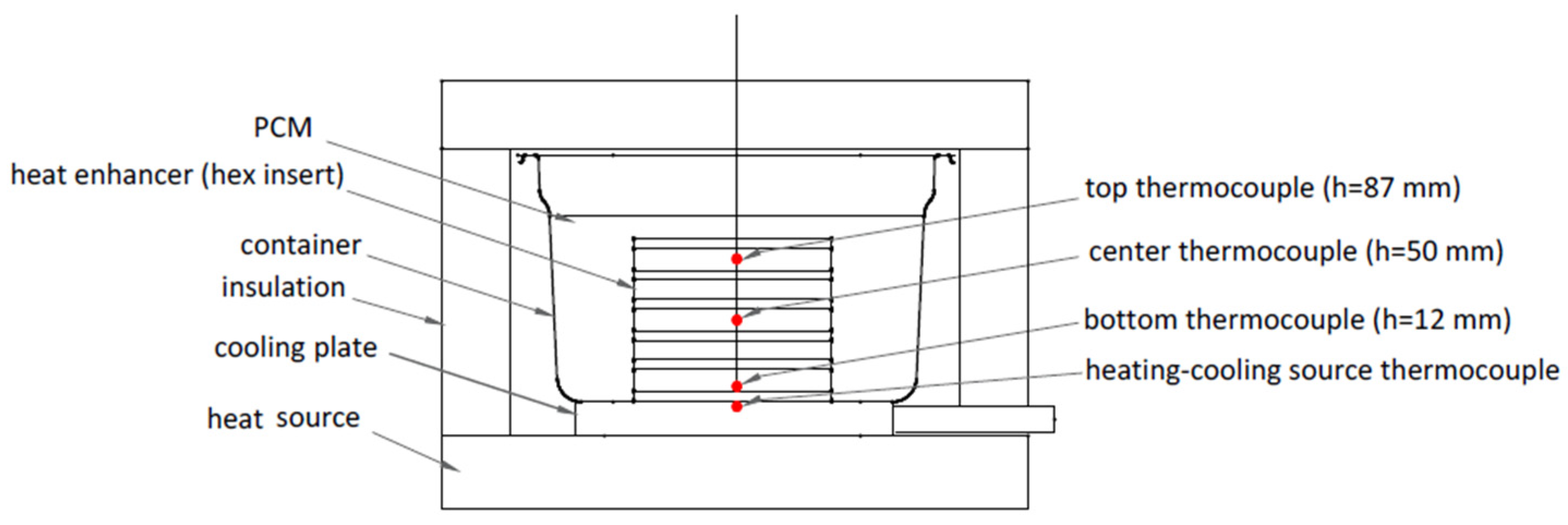
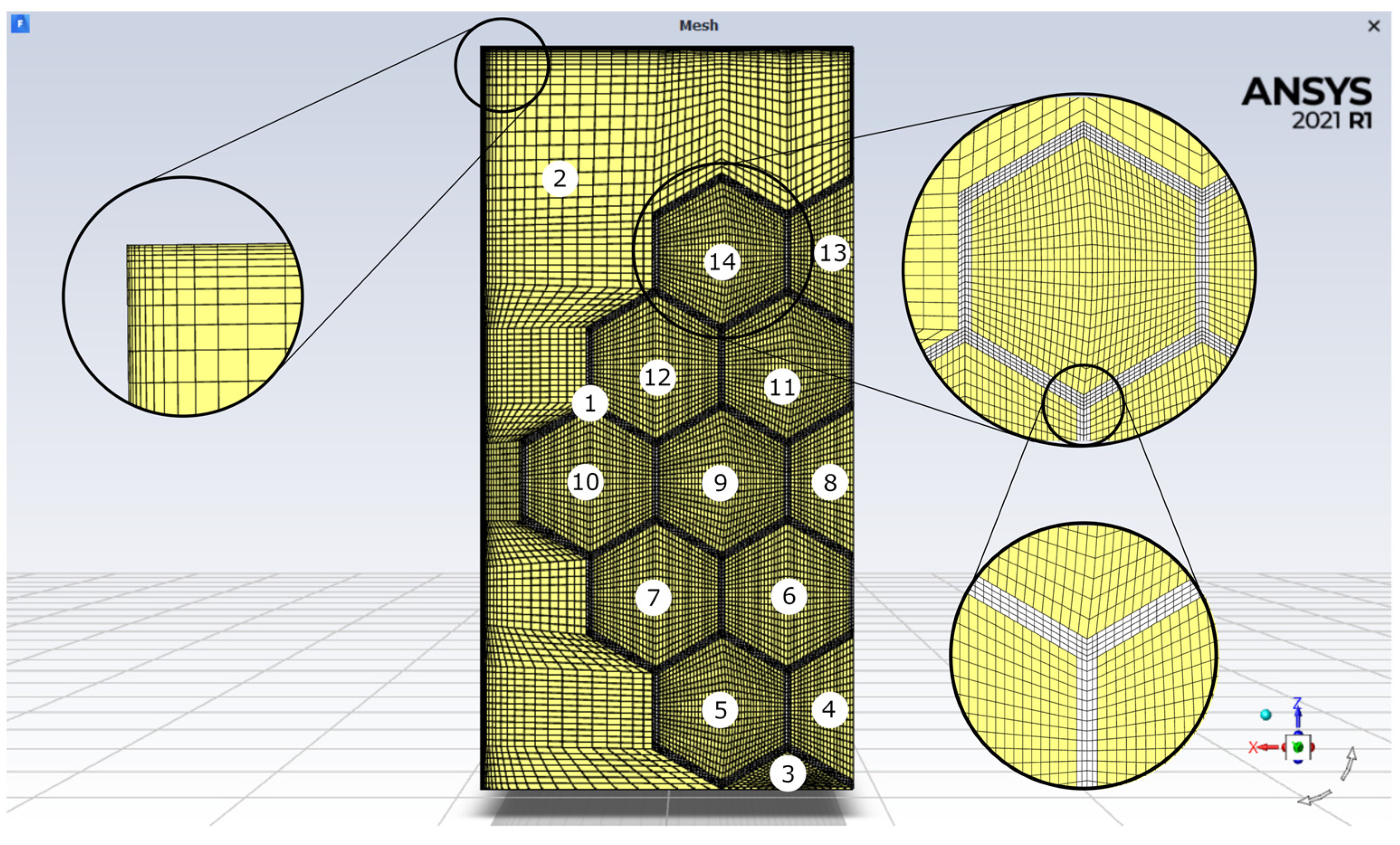
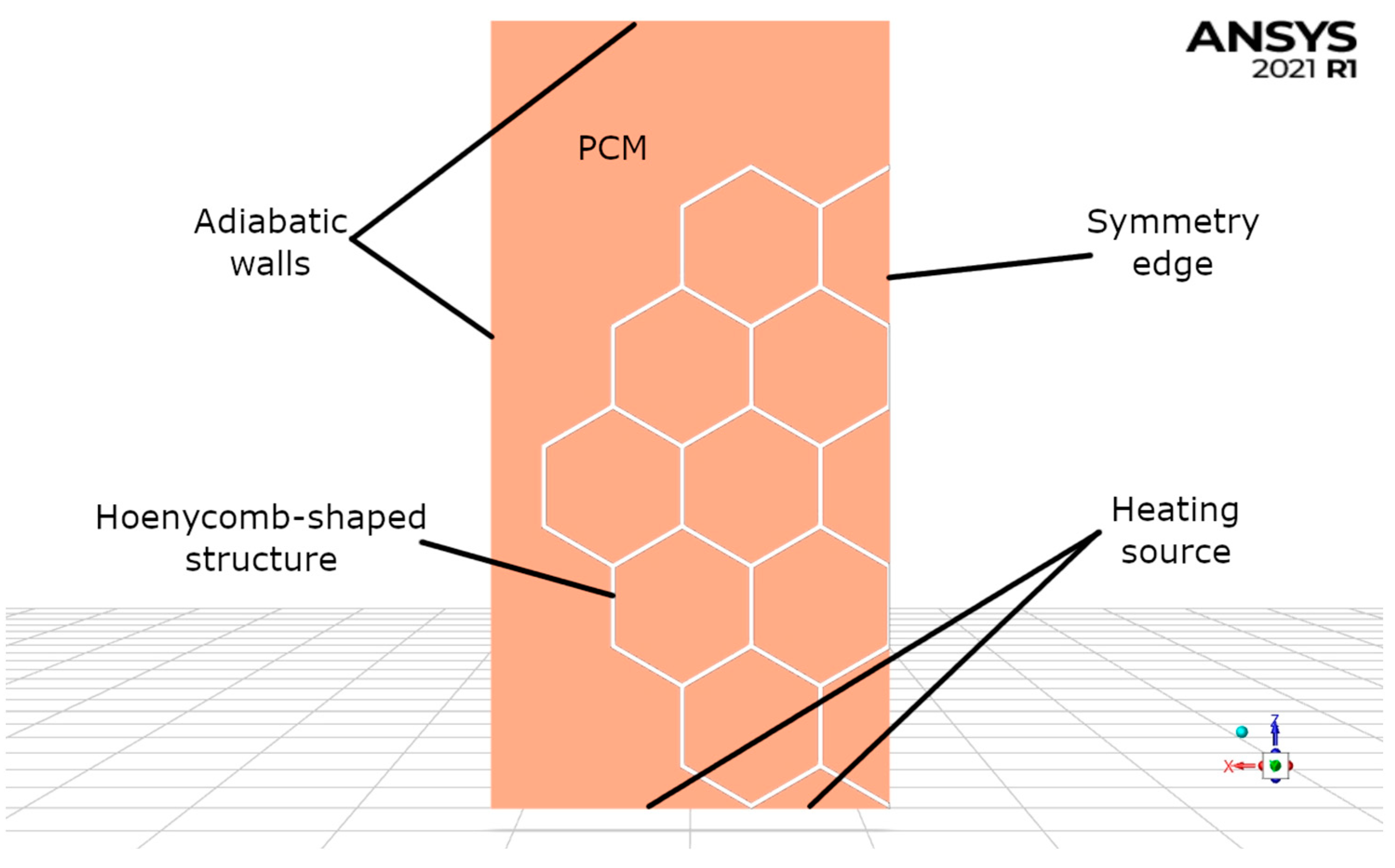
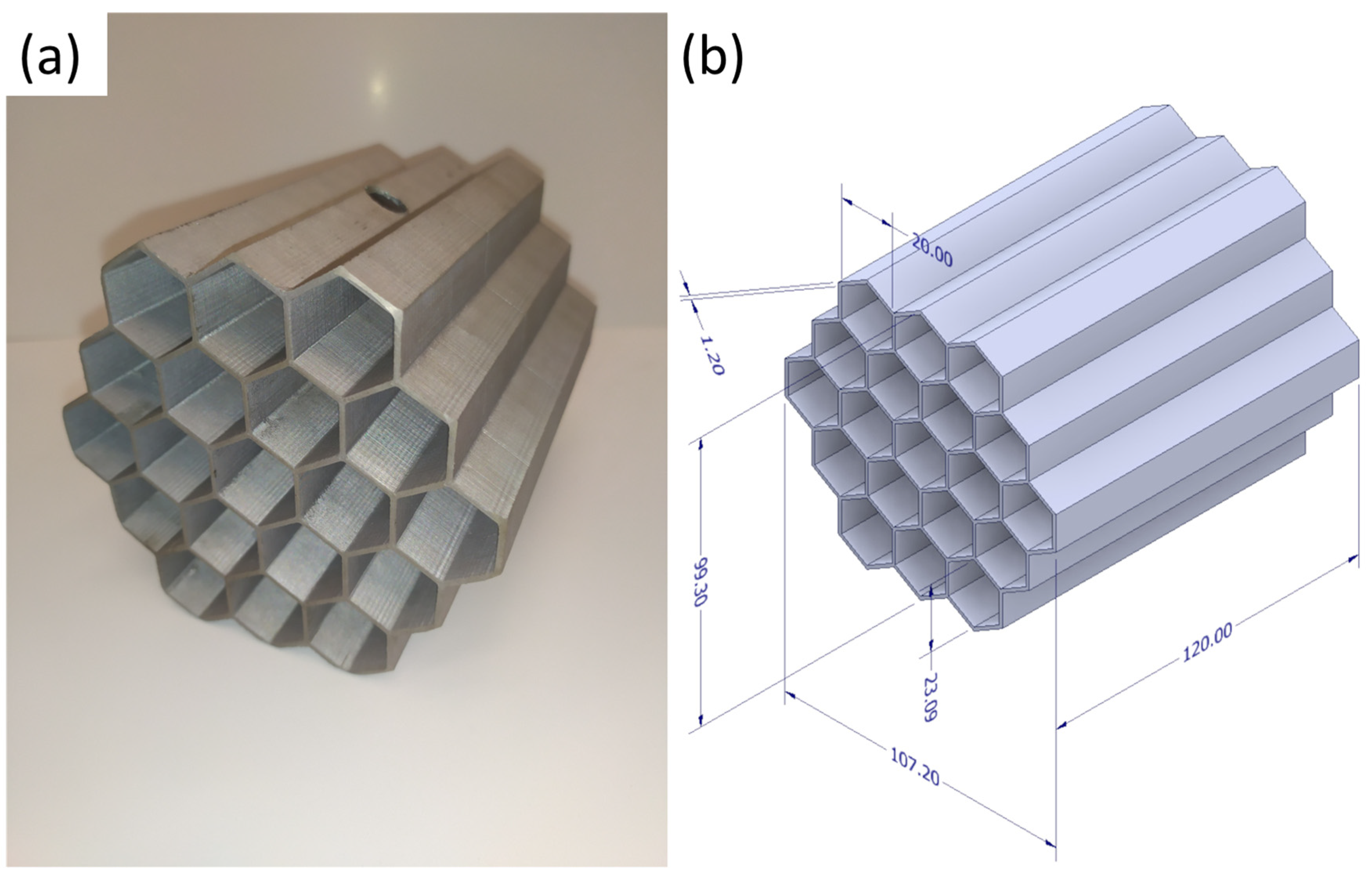

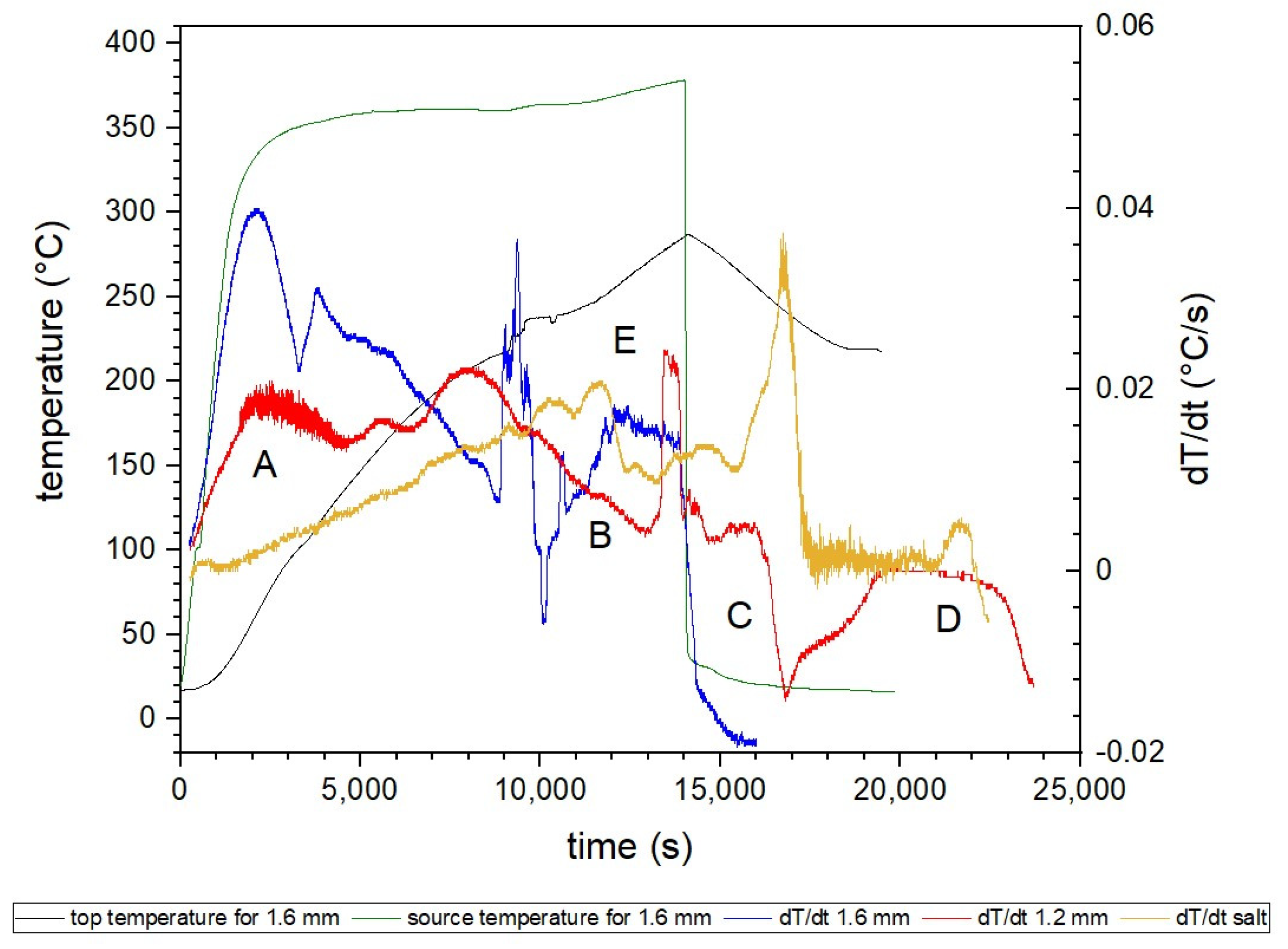
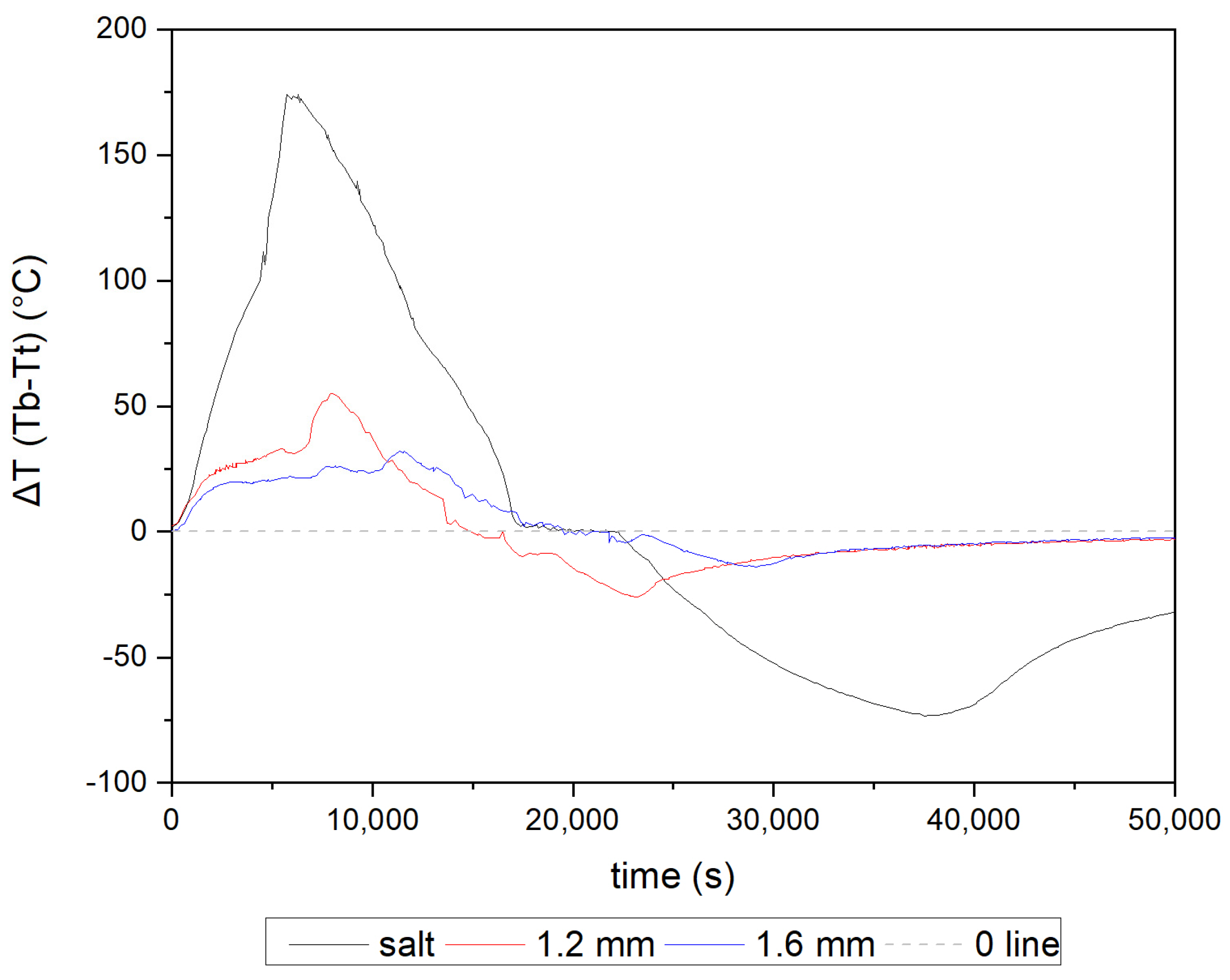
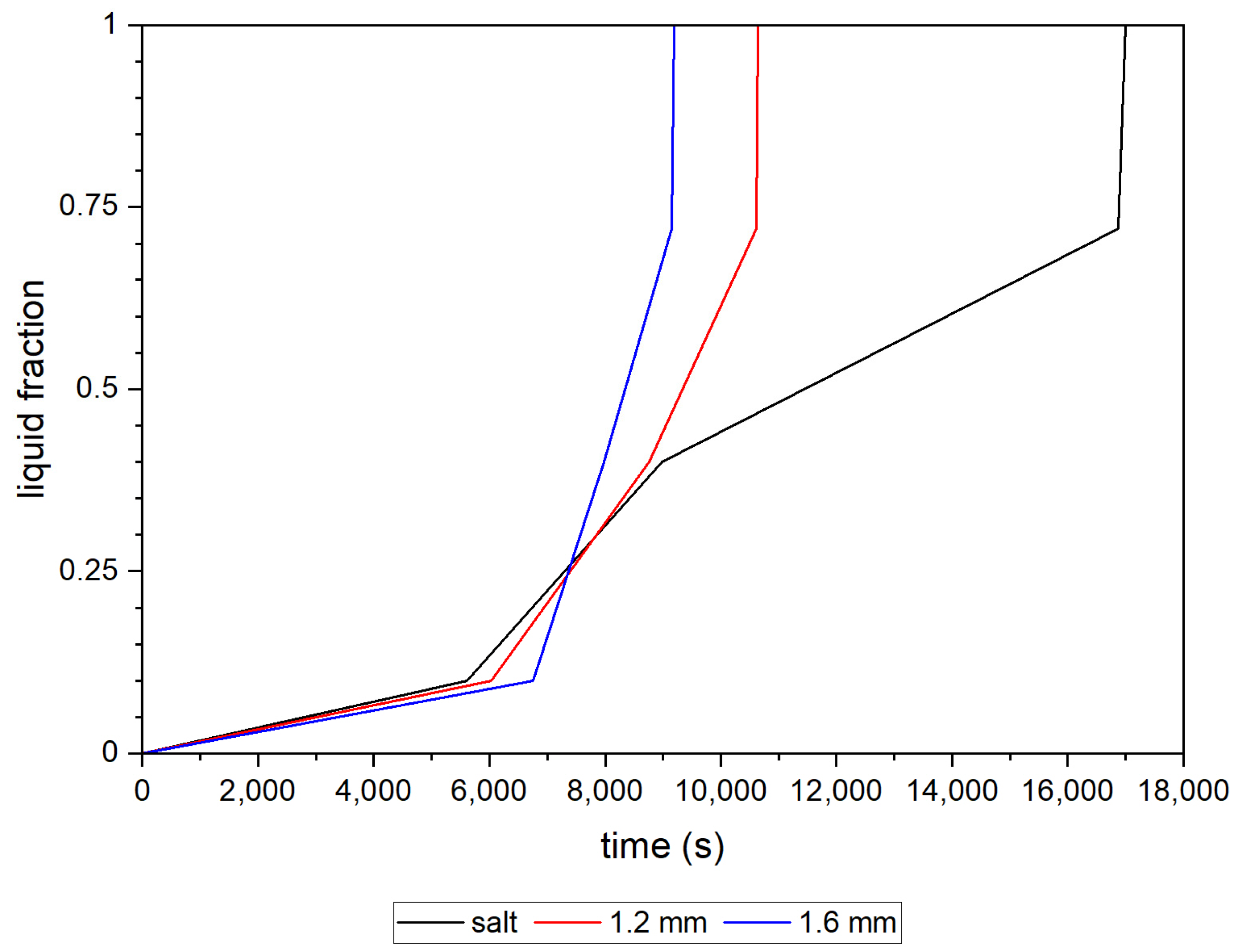
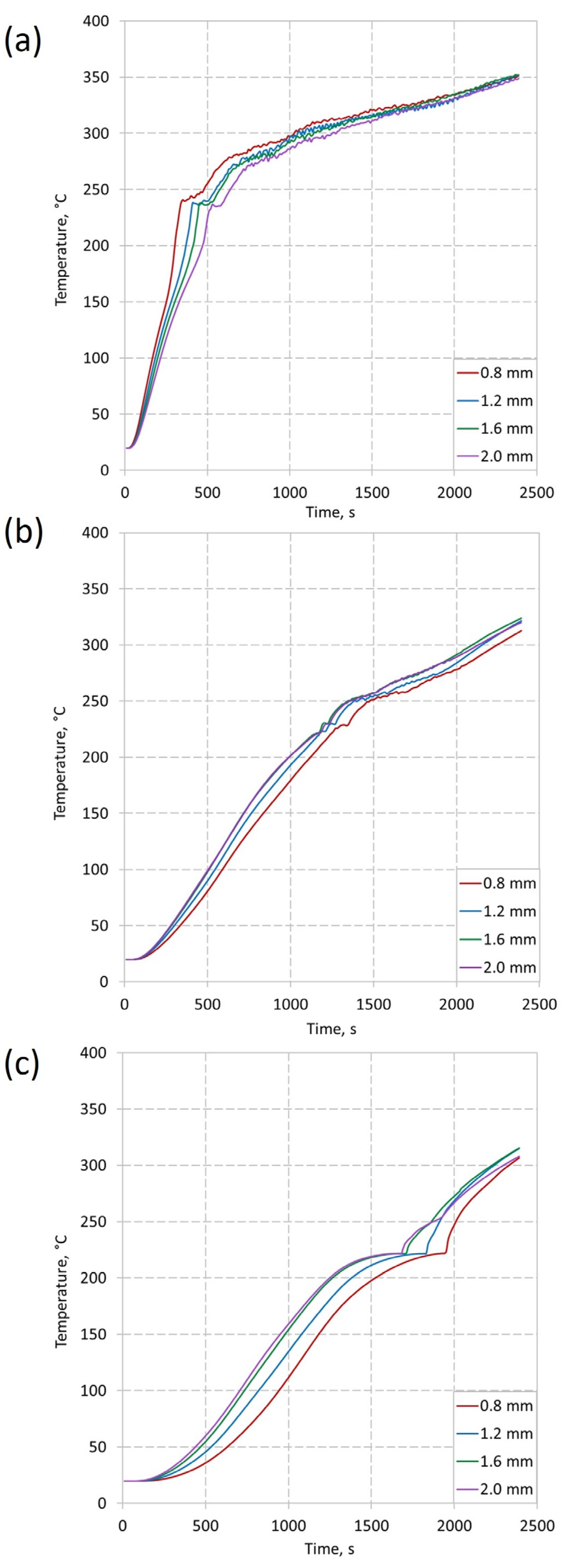
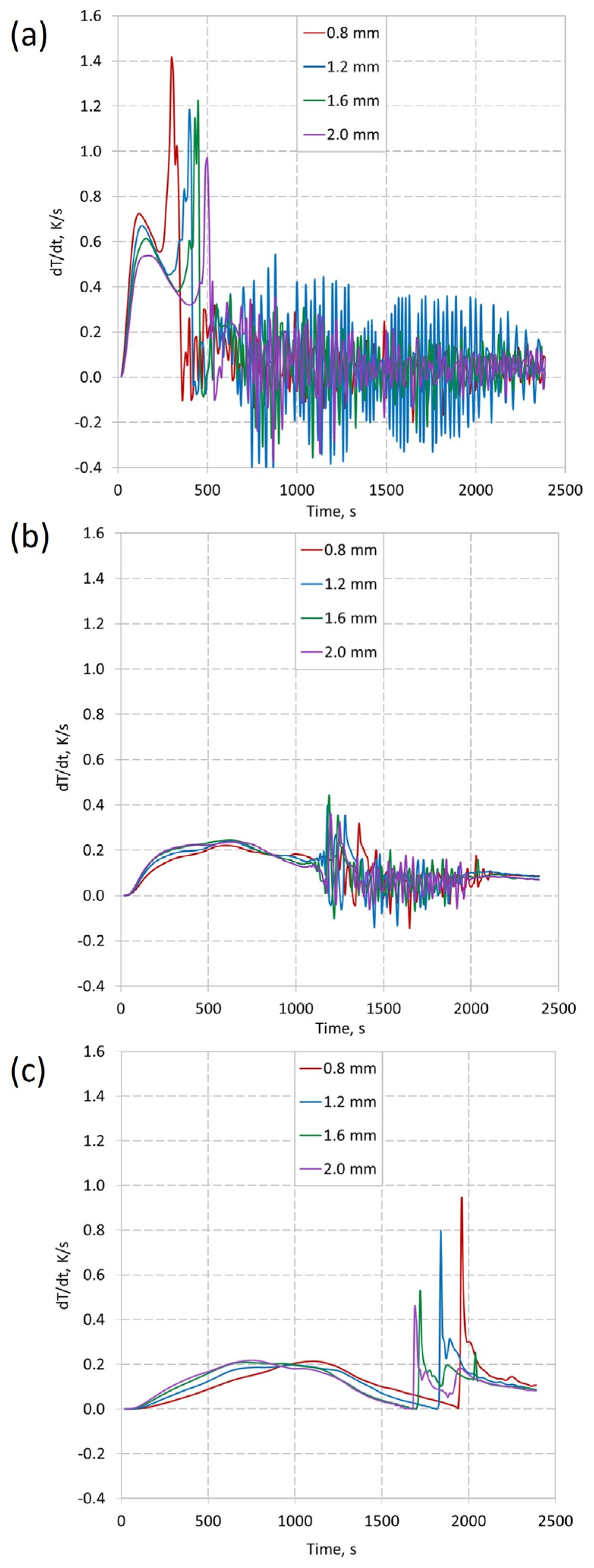
| Domain | Hexahedral Elements | Quality | Thickness of Elements Adjacent | ||
|---|---|---|---|---|---|
| Min | Max | Min | Max | ||
| 1 | 3168 | 1 | 1 | 0.400148 | 1.84752 |
| 2 | 3528 | 0.758 | 1 | 0.050000 | 1.47029 |
| 3, 8, 13 | 243 | 0.692 | 0.956 | 0.133432 | 1.15556 |
| 4–7, 9–12, 14 | 361 | 0.95 | 0.974 | 0.607737 | 1.21547 |
| Material | Density, kg/m3 | Specific Heat, J/(kg·K) | Thermal Conductivity, W/(m·K) | Dynamic Viscosity, kg/(m·s) | Melting Heat, J/kg | Melting Temperature, K |
|---|---|---|---|---|---|---|
| PCM | Equation (1) | 1492 | 0.457 | 0.0063 | 108,000 | 495 |
| Aluminum | 2644 | 960 | 160 | - | - | - |
| Time | PCM | 1.2 mm | 1.6 mm |
|---|---|---|---|
| t1 [s] | 4710–5590 | 5480–7540 | 5220–7920 |
| t2 [s] | 15,960–16,850 | 10,570–12,010 | 7850–10,400 |
| Δ (t2 − t1) range [s] | 10,950–11,900 | 4640–5700 | 2420–2620 |
| Δt average [s] | 11,425 | 5170 | 2520 |
| Δt average [min] | 190.42 | 86.17 | 42.00 |
| Temperature Gradient | PCM | 1.2 mm | 1.6 mm | |
|---|---|---|---|---|
| t1 | Tb [°C] | 218.3 | 218.8 | 218 |
| Tc [°C] | 98.1 | 191.5 | 204 | |
| Tt [°C] | 53.2 | 170.8 | 185.7 | |
| t2 | Tb [°C] | 230 | 231.1 | 232.6 |
| Tc [°C] | 229.5 | 232.3 | 230.7 | |
| Tt [°C] | 218.3 | 218.8 | 218 | |
| ΔT for t1 | 165.1 | 48 | 32.3 | |
Disclaimer/Publisher’s Note: The statements, opinions and data contained in all publications are solely those of the individual author(s) and contributor(s) and not of MDPI and/or the editor(s). MDPI and/or the editor(s) disclaim responsibility for any injury to people or property resulting from any ideas, methods, instructions or products referred to in the content. |
© 2023 by the authors. Licensee MDPI, Basel, Switzerland. This article is an open access article distributed under the terms and conditions of the Creative Commons Attribution (CC BY) license (https://creativecommons.org/licenses/by/4.0/).
Share and Cite
Raźny, N.; Dmitruk, A.; Nemś, A.; Nemś, M.; Naplocha, K. Optimization of Hexagonal Structure for Enhancing Heat Transfer in Storage System. Materials 2023, 16, 1207. https://doi.org/10.3390/ma16031207
Raźny N, Dmitruk A, Nemś A, Nemś M, Naplocha K. Optimization of Hexagonal Structure for Enhancing Heat Transfer in Storage System. Materials. 2023; 16(3):1207. https://doi.org/10.3390/ma16031207
Chicago/Turabian StyleRaźny, Natalia, Anna Dmitruk, Artur Nemś, Magdalena Nemś, and Krzysztof Naplocha. 2023. "Optimization of Hexagonal Structure for Enhancing Heat Transfer in Storage System" Materials 16, no. 3: 1207. https://doi.org/10.3390/ma16031207
APA StyleRaźny, N., Dmitruk, A., Nemś, A., Nemś, M., & Naplocha, K. (2023). Optimization of Hexagonal Structure for Enhancing Heat Transfer in Storage System. Materials, 16(3), 1207. https://doi.org/10.3390/ma16031207












